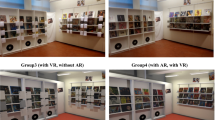Abstract
In any model of human information-processing, it is common to represent the cycle from perception to response. In this study, we focus on what happens in the intervals between cycles of work processes in the manufacturing industry. This topic has received little attention. We also visualize the status of visual searching during cyclic processes using eye-tracking. We found that anticipation occurred in preparation for making a decision on action in the next process, and thus contributes to the time taken from perception to response. Based on this result, we discuss the modeling of visual searching by humans.














Similar content being viewed by others
References
Agnieszka, B. (2006). Using eye tracking to compare web page designs: a case study. Journal of Usability Studies, 3(1), 112–120.
Asaoka, M. (2005). Ugoki no mohoo to image training (in Japanese). Journal of Biomechanism of Japan, 29(1), 31–35.
Atkinson, P. (2018). Invisible rhythms: Tracking aesthetic perception in films and the visual arts. In T. Dwyer, C. Perkins, S. Redmond, & J. Sita (Eds.), Seeing into screens—eye tracking and the moving image (pp. 28–43). Bloomsbury Academic.
Cornsweet, T. N. (1956). Determination of the stimuli for involuntary drifts and saccadic eye movements. Journal of the Optical Society of America, 46(11), 987–993.
Duchowski, A. T. (2017). Eye tracking methodology—theory and practice (3rd ed.). Springer.
Edwards, E. (1972). Man and machine: Systems for safety. In Proceedings of British Airline Pilots Association technical symposium (pp. 21–36). British Airline Pilots Association.
Fennema, M. G., & Kleinmunts, D. N. (1995). Anticipation of effort and accuracy in multiattribute choice. Organizational Behavior and Human Decision Processes, 63, 21–32.
Hawkins, F. H. (1987). Human factors in flight. Gower Publishing Company Ltd.
Ho, G., Scialfa, C. T., Caird, J. K., & Graw, T. (2001). Visual search for traffic signs: The effects of clutter, luminance, and aging. Human Factors, 43(3), 194–207.
Higgins, E., Leinenger, M., & Rayner, K. (2014). Eye movements when viewing advertisements. Frontiers in Psychology, 5, 1–15.
Holmqvist, K., Nyström, M., Andersson, R., Dewhurst, R., Jarodzka, H., & van de Weijer, J. (2011). Eye tracking—a comprehensive guide to methods and measures. Oxford University Press.
Kimura, A., Tada, M., Uozumi, T., & Goto, A. (2017). Teaching method of technique to make the braiding. In S. Trzcielinski (Ed.), Advances in ergonomics of manufacturing: Managing the enterprise of the future (pp. 310–321). Springer.
Martinez-Conde, S., Macknik, S. L., & Hubel, D. H. (2004). The role of fixational eye movements in visual perception. Nature Review Neuroscience, 5(3), 229–240.
Nakamura, J., Nagayoshi, S., & Komiya, N. (2021). Cognitive biases as clues to skill acquisition in manufacturing industry. In Proceedings of IEEE international conference on industrial engineering and engineering management (IEEM2021).
Stüttgen, P., Boatwright, P., & Monroe, R. T. (2012). A satisfying choice model. Marketing Science, 31(6), 878–899.
Suwa, M. (2005). Metacognitive verbalization as a tool for acquiring embodied expertise. Journal of the Japanese Society for Artificial Intelligence, 20(5), 525–532.
Suwa, M., & Hori, K. (2015). Ichininshou kenkyu no susume: Chinou kenkyu no atarasii choryuu [in Japanese]. Kindai Kagaku sha Co.
Wickens, C. D., Lee, J. D., Liu, Y., & Gordon Becker, S. E. (2004). An introduction to human factors engineering (2nd ed.). Pearson Education Inc.
Wright, P., Lickorish, A., & Milroy, R. (2000). Route choices, anticipated forgetting, and interface design for on-line reference documents. Journal of Experimental Psychology: Applied, 6(2), 158–167.
van der Lans, R., & Wedel, M. (2017). Eye movements during search and choice. In B. Wierenga & R. van der Lans (Eds.), Handbook of marketing decision models, international series in operations research and management science (pp. 331–359). Springer.
Vial, G. (2019). Understanding digital transformation: A review and a research agenda. Journal of Strategic Information Systems, 28(2), 118–144.
Xiao, H., Muthu, B., & Kadry, S. N. (2020). Artificial Intelligence with robotics for advanced manufacturing industry using robot-assisted mixed integer programming model. Intelligent Service Robotics. https://doi.org/10.1007/s11370-020-00326-7
Yarbus, A. L. (1967). Eye movements and vision (translated into English by Haigh). Plenum Press.
Acknowledgements
We thank all of the people who co-operated with us. We particularly thank Mr. Tano, President of Japan Pipe System Corporation. This research was supported by a Chuo University Grant for Special Research, and the Japan Society for the Promotion of Science (JSPS) (Grant nos. 17K03872 and 19K03062).
Author information
Authors and Affiliations
Corresponding author
Ethics declarations
Conflict of interest
On behalf of all authors, the corresponding author states that there is no conflict of interest.
Additional information
Publisher's Note
Springer Nature remains neutral with regard to jurisdictional claims in published maps and institutional affiliations.
Rights and permissions
About this article
Cite this article
Nakamura, J., Nagayoshi, S. & Komiya, N. Anticipation During a Cyclic Manufacturing Process: Toward Visual Search Modeling of Human Factors. Rev Socionetwork Strat 16, 599–614 (2022). https://doi.org/10.1007/s12626-022-00110-2
Received:
Accepted:
Published:
Issue Date:
DOI: https://doi.org/10.1007/s12626-022-00110-2




